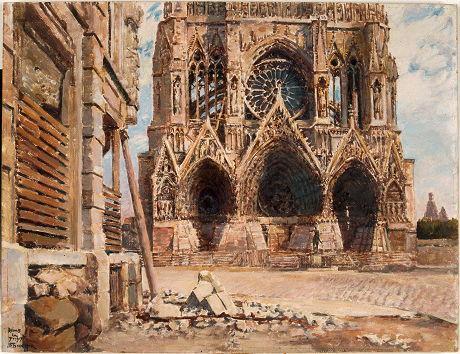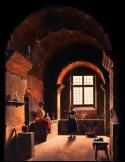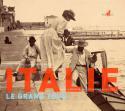Art Of The Day Weekly
#341 - from 10 April 2014 to 16 April 2014

Joseph Félix Bouchor, The Cathedral of Reims, 1917, oil on canvas, 26,8 x35 cm. Musée national de la coopération franco-américaine, Blérancourt, France © RMN-Grand Palais (Château de Blérancourt) / Gérard Blot.
IN THE AIR
A return to the cathedrals
ROUEN - Victor Hugo published Notre-Dame de Paris in 1831. Esmeralda and Quasimodo have become icons, immortalized to our day by Gina Lollobrigida and Anthony Quinn. Most important, the novel represented the great return of cathedrals in the collective memory. They were vilified during the revolution, Notre-Dame lost its sculptures and its spire, the cathedrals of Sens, Auxerre and others were damaged, but the Romantic writers and artists brought the cathedral back to life. This large exhibition tells the story of this return to rehabilitation. It shows, prior to Hugo, other great minds such as Goethe, who celebrated, as early as 1772, Erwin von Steinbach, the builder of the cathedral of Strasbourg, in his German Architecture. Then came the architects such as Viollet-le-Duc, the painters of history starting with Paul Delaroche, the Impressionists with Monet, the photographers (Nègre, Marville, Atget), up to the workshops of decorative arts which reproduced the motif to infinity. In 1914, the war and the bombing of the cathedral of Reims put a symbolic end to this second golden age.
• Cathédrales, un mythe moderne 1789-1914 at the musée des Beaux-Arts in Rouen, from 12 April to 31 August 2014.
EXHIBITIONS

François-Marius Granet, L'Alchimiste,oil on canvas, 61 x 48.3 cm. © Gift of Roy Eddleman, Chemical Heritage Foundation, Philadelphia / Photo: Will Brown.
Alchemy is no longer what it used to be
DUSSELDORF – It has been some time now since intelligent persons stopped trying to transform lead into gold. But brilliant minds spent centuries trying to transform similar matter, or others, including Newton and Goethe. In our so-called rational societies, we are regularly fascinated by the unknown and the unexplainable. Here comes the time of alchemy! The fashion of curiosity cabinets prepared us for this and we can actually see the reconstitution of a very beautiful one in the exhibition. The remaining 250 works of art show how the theme prevailed in painting, from Ancient times to the XIXth century, with interpreters as varied as Cranach, Rubens, Rembrandt or Granet. Following a clear loss of popularity that corresponds to the Industrial Revolution and the time of positivism, it reappeared with the Surrealists (Max Ernst) and survived sporadically after World War II (Beuys, Yves Klein, Kapoor). The exhibition is a true festival of disciplines and the result of an original collaboration with the Max Planck Institute for the history of science.
• Art and Alchemy at the Kunstpalast, from 5 April to 10 August 2014.
Saving Bandinelli
FLORENCE – He was considered for a long time as one of the major sculptors of the Renaissance, equal to Michael-Angelo, before falling into oblivion the victim of extended ostracism, under the battering of art historians throughout the XIXth and XXth centuries. One of the objectives of this pleasantly polemic exhibition is to see if Baccio Bandinelli (1493-1560) can be rehabilitated.
• Baccio Bandinelli at the Museo Nazionale del Bargello, from 9 April to 13 July 2014.
Another shade of Gris
PARIS – He is known as the alter ego of Braque and Picasso in the invention of Cubism. But next to his famous paintings of guitars, bottles and glasses, Juan Gris, who died too young (1887-1927), produced a lesser known work as a satirical drawer for the press (Le Rire, L’Assiette au beurre) of which this exhibition presents a nice array.
• Juan Gris, dibujos satíricos, at the Institut Cervantes, from 10 April to 6 June 2014.
Long live Cleopatra
PARIS – The Queen of Egypt is two thousand years old but has never seemed so young. She welcomed to her bed Cesar as well as Marc-Anthony and continues to personify beauty and seduction. Behind Sueton’s anathema and Liz Taylor’s mask, where does the truth lie regarding this great diplomat who dreamt of bringing Alexander the Great back to life? An answer is sought between all these archaeological pieces and Romantic ideas of the XXth century.
• Le mythe Cléopâtre at the Pinacothèque, from 10 April to 7 September 2014.
AUCTIONS

Félix Thiollier, Rails de chemin de fer traversant la campagne. Carbon print mounted on cardboard, image: 16.5x22.6cm; mounted: 24.2x 32 cm. Estimate: €800-1000.
Thiollier, an unknown pioneer
SAINT-ETIENNE – He was born and died in Saint-Etienne (1842-1914) and knew every dip and hill in the roads in his province, which he recorded in an impressive volume,
• Félix Thiollier 1842-1914, at the hôtel des ventes du Marais (Saint-Etienne) on 17 April 2014.
ARTIST OF THE WEEK
Meynard, fractal geometry
Picasso had his periods, Meynard’s work was divided into ‘geometries’. Following the hyperrealism when he began, marked by his flippers, his basketball players and his gigantic 7-meter long
• Jean-Claude Meynard is shown at the galerie Lélia Mordoch, from 11 April to 17 May 2014.
OPENINGS OF THE WEEK
BOOKS
The great Italian tour
We all take thousands of photographs, fill our hard disks and slow down our computers. We know how to see. But do we know how to simply look? In order to really appreciate a monument, a site, are they not dissociated from time, from patience? This is the insidious question the images by travelers and photographers from the XIXth century ask in the Bel Paese. From Venice to Paestum, from Florence to Rome, amateurs at the time had to save on expensive material (glass plates, albumin paper) and had to deal with exposure times that could not be shortened. It was therefore important to choose one’s image well –be it by creating a setting- before immortalising it… Can this explain the fact these photographs have travelled through time? The jetty of San Remo, the arcades of Bologna, an excursion to the Vesuvius, prickly pears and mummies of the Capuchins in Palermo, all these timeless classics. Almost too classic: we regret the trip does not also take us to the Pugglie, Calabria, the Abruzze region, or that of the Marche. Fortunately there is also Instagram…
• Italie, le Grand Tour, dans le miroir de la photographie au XIXe siècle, by Giovanni Fanelli and Barbara Mazza, published by Nicolas Chaudun, 2013, 352 p., €50.



